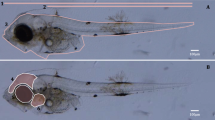Abstract
The three broodCeriodaphnia dubia test was carried out three nonconsecutive times, each period being separated by the previous one by three weeks. The toxicant studied was sodium lauryl sulfate (SLS) which bacterially degrades completely by the end of the third day of the test. The mean LC50 based on survival was 41±3.2 (CV = 7.8%) mg/L for day 3 through day 6. The mean EC50 based on progeny confirmed the LC50 and was 36 ± 0.49 (CV = 1.4%) mg/L for the ultimate day of the test. The close reproducibility among successive tests is due in part to the use of pure SLS, the use of a mixed algal diet and in part to reducing handling to a minimum. Data failed to indicate any chronic effect exhibited byC. dubia populations since no statistically significant differences were noted between 48 hr (acute) and 144 hr values (chronic). Calculations of brood size for the first four broods clearly indicate a chronic effect of SLS onC. dubia by showing a progressively greater spread between the highest mean brood size and the lowest mean brood size as the brood number increases. It is suggested that calculations of this kind become part of theCeriodaphnia test methodology so that any chronicity can be better identified
Similar content being viewed by others
References
Berner DB (1986) Taxonomy ofCeriodaphnia (Crustacea: cladorcera) in US Environmental Protection Agency Culture. EPA/600/4-86/032, Cincinnati, OH
Cowgill UM (1987) Critical analysis of factors affecting the sensitivity of Zooplankton and the reproducibility of toxicity test results. Water Res 21:1453–1462
Cowgill UM, Milazzo DP (1989) New approach to the seven-dayCeriodaphnia dubia test with additional comments pertaining to the same test forDaphnia magna. Bull Environ Contam Toxicol 42:749–753
Cowgill UM, Milazzo DP, Meagher CK (1988) New diet forCeriodaphnia dubia. Bull Environ Contam Toxicol 41:304–309
Keating KI (1985) The influence of B12 deficiency on the reproduction ofDaphnia pulex Leydig (Cladocera). J Crust Biol 5:130–136
Keating KI, Dagbuson BC (1984) Effect of selenium deficiency on cuticle integrity in the Cladocera (Crustacea). Proc Natn Acad Sci USA 81:3433–3437
Mount DI and Norberg, TJ (1984) A seven-day life-cycle cladoceran toxicity test. Environ Toxicol Chem 3:425–434
Tovell PWA, Newsome C, Howes D (1974) Effect of water hardness on the toxicity of an anionic detergent to fish. Water Res 8:291–296
Wakabayashi M, Kikuchi M, Inoue W, Kawahara H, Koido Y (1975) Toxicity of detergents to some aquatic organisms I Acute toxicity of anionic surfactants toOryzias latipes. Suisan Zoshoku 23:119–124 (in Japanese)
Winner RW (1988) Evaluation of the relative sensitivities of 7-dayDaphnia magna andCeriodaphnia dubia toxicity tests for cadmium and sodium pentachlorophenate. Environ Toxicol Chem 7:153–159
Author information
Authors and Affiliations
Rights and permissions
About this article
Cite this article
Cowgill, U.M., Milazzo, D.P. & Landenberger, B.D. The reproducibility of the three broodCeriodaphnia test using the reference toxicant sodium lauryl sulfate. Arch. Environ. Contam. Toxicol. 19, 513–517 (1990). https://doi.org/10.1007/BF01059069
Received:
Revised:
Issue Date:
DOI: https://doi.org/10.1007/BF01059069




